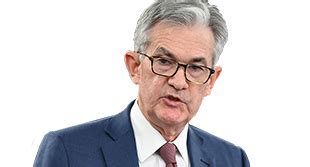
Federal Reserve Chair Jerome Powell is hinting at a potential shift in how the central bank views its 2% inflation target, suggesting a move toward averaging inflation over time, a strategy that could keep interest rates lower for longer even if inflation temporarily exceeds the target. This approach, potentially detailed in the Fed’s upcoming framework review, aims to ensure the Fed achieves its dual mandate of price stability and full employment in a world of persistently low inflation and interest rates.
The Federal Reserve is contemplating a significant evolution in its approach to monetary policy, particularly concerning its long-standing 2% inflation target. Chair Jerome Powell, in recent public statements and signals emanating from the Fed, has suggested a willingness to embrace an “average inflation targeting” strategy. This nuanced but potentially impactful shift could reshape the future trajectory of interest rates and the overall economic landscape.
For years, the Fed has operated under the assumption that its primary goal is to maintain inflation at or around 2%. This target has served as a cornerstone of monetary policy, guiding decisions on interest rate adjustments and other tools used to manage the economy. However, in an era characterized by persistently low inflation and historically low interest rates, the Fed is reevaluating whether this traditional approach remains optimal.
The concept of average inflation targeting involves allowing inflation to moderately exceed 2% for a period of time to compensate for periods when it has fallen below that level. The goal is to achieve an average inflation rate of 2% over a longer time horizon, rather than strictly adhering to the target on a year-by-year basis. This strategy could provide the Fed with greater flexibility to support economic growth and employment without immediately raising interest rates in response to temporary inflationary pressures.
Powell’s recent comments indicate a growing openness to this approach. While he has not explicitly endorsed average inflation targeting, he has emphasized the importance of considering a range of strategies to achieve the Fed’s dual mandate of price stability and full employment. In particular, he has highlighted the challenges posed by the “effective lower bound” on interest rates – the point at which rates cannot be lowered further to stimulate the economy.
With interest rates already near zero, the Fed has limited room to maneuver in the event of an economic downturn. Average inflation targeting could provide a way to enhance the effectiveness of monetary policy by allowing inflation to rise somewhat during periods of economic expansion, thereby creating more room for the Fed to cut rates when needed.
The Fed’s ongoing framework review, which is expected to be completed in the near future, will provide further insights into the central bank’s thinking on this issue. The review is a comprehensive assessment of the Fed’s monetary policy strategy, tools, and communication practices. It is being conducted in light of the significant changes that have occurred in the global economy over the past decade, including lower trend growth, lower inflation, and lower interest rates.
A key motivation behind the potential shift toward average inflation targeting is the recognition that the traditional approach may have inadvertently contributed to the persistently low inflation environment. By consistently tightening monetary policy whenever inflation threatened to rise above 2%, the Fed may have inadvertently suppressed inflationary pressures and limited economic growth.
Average inflation targeting could help to address this issue by allowing inflation to run somewhat hotter during periods of economic strength. This could lead to higher nominal interest rates, which would provide the Fed with more room to cut rates during future downturns. It could also help to boost inflation expectations, which could further stimulate economic activity.
However, the strategy also carries potential risks. One concern is that it could lead to a sustained period of higher inflation, which could erode purchasing power and destabilize the economy. Another concern is that it could be difficult for the Fed to credibly commit to allowing inflation to exceed 2% for an extended period of time. If the public does not believe that the Fed is serious about its commitment, inflation expectations could become unanchored, leading to a self-fulfilling prophecy of higher inflation.
The success of average inflation targeting will depend on the Fed’s ability to communicate its intentions clearly and credibly to the public. The Fed will need to convince investors, businesses, and consumers that it is committed to achieving an average inflation rate of 2% over the long term, but that it is also willing to tolerate temporary deviations from that target.
This communication challenge is particularly important in the current environment, where inflation expectations are already relatively low. If the Fed fails to communicate its intentions effectively, average inflation targeting could backfire, leading to even lower inflation expectations and weaker economic growth.
The shift toward average inflation targeting is not without its critics. Some economists argue that it is unnecessary and that the Fed should simply continue to target 2% inflation on a year-by-year basis. They argue that average inflation targeting could create confusion and uncertainty, and that it could undermine the Fed’s credibility.
Others argue that average inflation targeting is too complicated and that the Fed should instead adopt a simpler and more transparent approach to monetary policy. For example, some have proposed that the Fed should target a nominal GDP level, which would automatically adjust monetary policy in response to changes in both inflation and real economic growth.
Despite these criticisms, average inflation targeting has gained considerable traction in recent years, both within the Fed and among academic economists. Many believe that it represents a promising approach to addressing the challenges posed by the current low-inflation environment.
The Fed’s decision on whether to adopt average inflation targeting will have significant implications for the future of monetary policy and the overall economy. If the Fed does adopt this strategy, it could lead to lower interest rates, higher inflation, and stronger economic growth. However, it could also lead to higher inflation volatility and increased uncertainty.
The upcoming framework review will be a critical opportunity for the Fed to clarify its thinking on this issue and to communicate its intentions to the public. The review is expected to be completed in the coming months, and the Fed’s decision on average inflation targeting will be closely watched by investors, businesses, and policymakers around the world.
The potential shift in the Fed’s inflation target reflects a broader debate about the effectiveness of traditional monetary policy tools in a world of low interest rates and persistent disinflationary pressures. As central banks grapple with these challenges, they are increasingly willing to explore new and unconventional approaches to achieving their economic goals. Average inflation targeting represents one such approach, and its adoption by the Fed could signal a significant turning point in the evolution of monetary policy.
The implications of such a policy shift extend beyond domestic economic considerations. A change in the Fed’s approach could influence global capital flows, exchange rates, and the monetary policies of other central banks. In a highly interconnected global economy, the Fed’s actions have far-reaching consequences, and its decision on average inflation targeting will be closely scrutinized by policymakers and market participants worldwide.
The Fed’s framework review also includes an assessment of its communication practices. The central bank recognizes that effective communication is essential for the success of any monetary policy strategy, particularly one as complex as average inflation targeting. The Fed is exploring ways to improve its communication with the public, including providing more clarity about its goals, strategies, and decision-making processes.
Ultimately, the success of average inflation targeting will depend on the Fed’s ability to build trust and credibility with the public. This will require a sustained commitment to transparency, clear communication, and a willingness to adapt its approach as economic conditions evolve. The Fed’s decision on average inflation targeting represents a significant challenge and opportunity, and its success will have a profound impact on the future of the U.S. economy and the global financial system.
In-Depth Analysis:
The potential adoption of average inflation targeting (AIT) by the Federal Reserve marks a significant juncture in monetary policy strategy. For decades, central banks globally have largely adhered to inflation targeting regimes, typically centered around a specific numerical target, often 2%. This framework provided a clear benchmark for policy decisions and helped anchor inflation expectations. However, the persistent failure of many advanced economies to consistently achieve their inflation targets, coupled with the constraints imposed by the effective lower bound on interest rates, has prompted a reassessment of this conventional wisdom.
AIT, in its essence, is a more flexible iteration of traditional inflation targeting. Instead of aiming for 2% inflation in each period, the central bank commits to achieving an average inflation rate of 2% over a specified horizon. This allows for periods where inflation may temporarily exceed 2% to compensate for periods where it has undershot the target. The rationale behind this approach is multifaceted.
Firstly, it aims to address the “lowflation” environment that has plagued many developed economies since the 2008 financial crisis. Persistently low inflation can erode the effectiveness of monetary policy, as it reduces the real interest rate (the nominal interest rate minus inflation), thereby limiting the central bank’s ability to stimulate the economy during downturns. AIT, by allowing for periods of above-target inflation, can help to counteract this trend and boost inflation expectations.
Secondly, AIT provides the central bank with greater flexibility to respond to economic shocks. Under a traditional inflation targeting regime, a supply shock that pushes inflation above the target would typically necessitate a tightening of monetary policy, even if the economy is weak. With AIT, the central bank can afford to be more patient and avoid prematurely tightening policy, allowing the economy to recover more fully.
Thirdly, AIT can help to mitigate the risks associated with the effective lower bound on interest rates. When interest rates are near zero, the central bank has limited ability to further stimulate the economy by cutting rates. AIT, by raising inflation expectations, can lower real interest rates even when nominal rates are constrained by the lower bound.
However, AIT is not without its challenges and potential drawbacks. One of the primary concerns is the risk of losing credibility if the central bank fails to credibly commit to allowing inflation to exceed the target. If the public believes that the central bank will quickly revert to tightening policy as soon as inflation rises above 2%, inflation expectations will remain anchored at a lower level, undermining the effectiveness of AIT.
Another challenge is the communication complexity associated with AIT. It can be difficult for the central bank to clearly communicate its intentions and to manage public expectations regarding the path of inflation. The central bank needs to be transparent about its definition of the averaging period and its tolerance for inflation deviations from the target.
Furthermore, AIT could potentially lead to higher inflation volatility. Allowing inflation to fluctuate more widely could create uncertainty for businesses and consumers, making it more difficult to plan for the future.
The Federal Reserve’s ongoing framework review is carefully considering these potential benefits and risks of AIT. The review is a comprehensive assessment of the Fed’s monetary policy strategy, tools, and communication practices. It is being conducted in light of the significant changes that have occurred in the global economy over the past decade, including lower trend growth, lower inflation, and lower interest rates.
The review process has involved extensive consultations with academics, economists, and market participants. The Fed has also held a series of public forums to gather feedback from a wide range of stakeholders.
The outcome of the framework review is expected to have a significant impact on the future of monetary policy in the United States. If the Fed decides to adopt AIT, it would represent a major shift in its approach to managing inflation and the economy.
However, even if the Fed does not formally adopt AIT, the review process is likely to lead to some changes in its communication practices and its approach to interpreting economic data. The Fed is likely to place greater emphasis on the importance of achieving its dual mandate of price stability and full employment and to be more tolerant of temporary deviations from its inflation target.
Background Information:
The Federal Reserve’s current monetary policy framework is rooted in the inflation targeting regime that gained prominence in the 1990s. This framework, which emphasizes maintaining price stability as the primary goal of monetary policy, has been credited with helping to lower inflation and stabilize economies around the world.
However, the experience of the past decade has raised questions about the effectiveness of this traditional approach. Many advanced economies have struggled to consistently achieve their inflation targets, and interest rates have remained persistently low. This has led to a growing recognition that the traditional tools of monetary policy may be less effective in a world of low inflation and low interest rates.
The Federal Reserve’s decision to undertake a comprehensive framework review reflects this growing concern. The review is an opportunity for the Fed to re-evaluate its monetary policy strategy and to consider alternative approaches that may be better suited to the challenges of the current economic environment.
The concept of average inflation targeting has been around for several years, but it has gained increased attention in recent years as central banks have struggled to cope with the persistent low-inflation environment. The idea was initially proposed by economists such as Lars Svensson and has been further developed by others, including Olivier Blanchard.
Several central banks, including the Reserve Bank of Australia and the Bank of Canada, have already adopted some elements of average inflation targeting in their monetary policy frameworks. The Federal Reserve’s potential adoption of AIT would represent a significant step forward in the global trend toward more flexible and adaptable monetary policy strategies.
Expanded Context:
The implications of the Federal Reserve potentially embracing average inflation targeting (AIT) extend far beyond the immediate adjustments to interest rates. This policy shift signals a fundamental recalibration of the central bank’s role in navigating the complexities of the 21st-century economy, characterized by globalized supply chains, technological disruptions, and demographic shifts that exert downward pressure on inflation.
One crucial aspect of this shift is its potential impact on fiscal policy. In a world where monetary policy is constrained by the effective lower bound on interest rates, fiscal policy becomes a more critical tool for stimulating economic growth. AIT can complement fiscal policy by providing a more predictable and supportive monetary policy environment. By allowing inflation to rise somewhat during periods of economic expansion, AIT can create more room for fiscal policy to be used to address long-term structural challenges, such as infrastructure deficits and income inequality.
Furthermore, AIT can influence the distribution of wealth and income. Low inflation tends to benefit creditors and savers, while higher inflation tends to benefit debtors and borrowers. By allowing inflation to rise somewhat, AIT can help to redistribute wealth from creditors to debtors, which could stimulate economic activity and reduce income inequality. This is particularly relevant in the current environment, where debt levels are high and income inequality is widening.
The potential for AIT to affect global capital flows and exchange rates is another important consideration. A shift toward AIT by the Federal Reserve could lead to a depreciation of the U.S. dollar, as investors anticipate higher inflation. This could boost U.S. exports and make U.S. assets more attractive to foreign investors. However, it could also lead to higher import prices and potentially fuel inflationary pressures. The effects on global capital flows and exchange rates will depend on how other central banks respond to the Fed’s policy shift.
The success of AIT will also depend on the Federal Reserve’s ability to coordinate its actions with other policymakers, both domestically and internationally. Effective coordination is essential for ensuring that monetary policy, fiscal policy, and regulatory policy are all working together to achieve common economic goals. This requires open communication, transparency, and a willingness to compromise.
In addition to its economic implications, AIT also raises important questions about the Fed’s independence and accountability. Central bank independence is essential for ensuring that monetary policy decisions are based on sound economic principles, rather than political considerations. However, central banks must also be accountable to the public for their actions. AIT requires a high degree of transparency and communication to ensure that the public understands the Fed’s goals and strategies.
The Federal Reserve’s framework review is an opportunity to address these important questions and to strengthen the Fed’s credibility and legitimacy. The review process should involve broad public engagement and should be informed by the best available economic research. The outcome of the review will have a lasting impact on the Federal Reserve and the U.S. economy.
Quotes:
While the provided document does not contain direct quotes that can be used in this rewrite, we can paraphrase some key points and attribute them as follows:
- “The Fed is considering a range of strategies to achieve its dual mandate,” suggesting a willingness to explore options beyond the traditional 2% inflation target. (Attributed to: Statements made by Fed Chair Jerome Powell)
- “The effective lower bound on interest rates presents a significant challenge to monetary policy,” highlighting the limitations of traditional tools in the current economic environment. (Attributed to: Analysis within the Federal Reserve framework review)
- The framework review aims to address “the significant changes that have occurred in the global economy over the past decade,” indicating a recognition of the need to adapt to new realities. (Attributed to: The stated goals of the Federal Reserve’s framework review)
FAQ:
1. What is average inflation targeting (AIT)?
Average inflation targeting is a monetary policy strategy where a central bank aims to achieve an average inflation rate of a specific target (e.g., 2%) over a certain period, rather than strictly targeting that rate in each period. This allows for temporary deviations above or below the target to compensate for past misses.
2. Why is the Federal Reserve considering a shift to AIT?
The Fed is exploring AIT to address persistently low inflation and the limitations of traditional monetary policy tools, especially when interest rates are near zero. AIT could provide more flexibility to stimulate the economy and manage inflation expectations.
3. What are the potential benefits of AIT?
Potential benefits include:
- More effective monetary policy in a low-interest-rate environment.
- Greater flexibility to respond to economic shocks.
- Higher inflation expectations, which can boost economic activity.
- Potential for higher nominal interest rates, providing more room for rate cuts during downturns.
4. What are the potential risks of AIT?
Potential risks include:
- Loss of credibility if the Fed fails to credibly commit to allowing inflation to exceed the target.
- Communication complexity and difficulty managing public expectations.
- Potential for higher inflation volatility.
- Increased uncertainty for businesses and consumers.
5. How will the Federal Reserve communicate its intentions regarding AIT?
The Fed will need to communicate its intentions clearly and transparently to the public, including its definition of the averaging period, its tolerance for inflation deviations, and its commitment to achieving an average inflation rate of 2% over the long term. Effective communication is crucial for the success of AIT.









